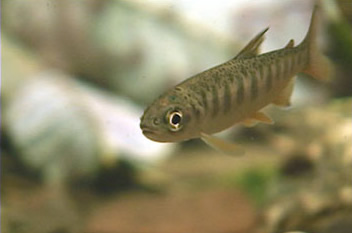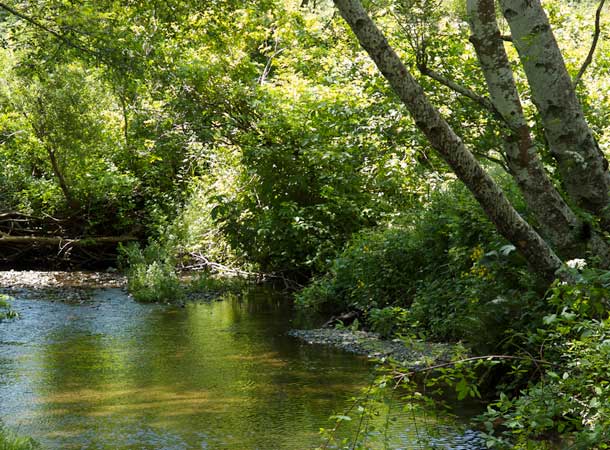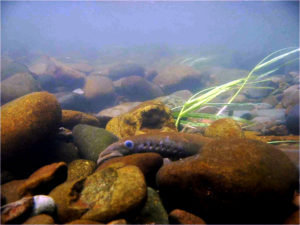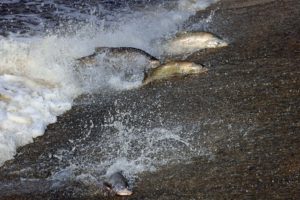This article is part of our EndangerBus project — watch for the buses in San Francisco January 2011!
- Salmon need shady creeks with clean, cool water. This is a view of a lagoon at Muir Beach that’s being restored by the Golden Gate National Recreation Area.
Only 150 years ago, rivers and streams were the central transportation routes for millions of people and tons of goods the world over. In some places, they still are. And for some animals, they always will be.
Along the coast of Northern California, nearly every stream and creek once had its own migratory population of coho salmon, who have an uncanny ability to return to their home streams after years at sea.

- Coho salmon fry, from Fresh Waters Flowing, video by Alan Honick.
Their return each winter, once as reliable as the next train or bus, now happens in fewer and fewer places each year and, in many places, not at all. Where the fish do return, it’s often thanks to dedicated volunteers working to keep creeks healthy enough for the salmon, arguably our region’s most charismatic nomads.
The closest coho streams to San Francisco run in West Marin: a tiny remnant run in Redwood Creek, which connects to the ocean at Muir Beach, and a larger but also struggling population in Lagunitas Creek, which feeds into Tomales Bay.
The Golden Gate National Recreation Area is in the midst of a multi-year project to restore salmon habitat at Muir Beach, while the nonprofit Salmon Protection and Watershed Network (SPAWN) has tirelessly worked to restore the coho of Lagunitas for years. In addition to restoration and advocacy work, SPAWN leads popular guided salmon-spotting walks every winter.
The Lagunitas run, which numbered 6,000 fish as recently as the 1960s, is down to about 500 fish today. Not many, but things are so bad statewide that these few fish make up 10 to 20 percent of the state’s remaining wild coho. (Other species of salmon, like chinook, are doing marginally better, and steelhead trout better still–but even steelhead, which are more tolerant of pollution and warmer waters, are down 90 percent from historic levels across California.)
For millions of years, coho have lived by a three-year rhythm: Baby salmon emerge from gravel nests and spend their first year growing in their birth watershed. This is when they most need good stream habitat — clean water, plenty of bugs to eat, shaded banks to keep the water cool and clear, deep pools that stay wet through our long dry season, and hiding spots made by underwater rocks, roots, and fallen trees. The next year they make their way downstream, pausing in the stream mouth, then heading out for two years of life at sea before returning to the streams in which they were born.
That three-year cycle means that populations are staggered, and a high return of salmon one year can be followed by a drastically smaller run the next. To further complicate matters, salmon experts have little sense of what the fish do once they get to the Pacific, though fishing statistics can give some indication of population trends.
Because their life cycle bridges so many different environments, it’s hard to know whether problems are caused by warmer stream conditions, more sediment, changes in ocean temperatures, lack of food, something else, or many of these things combined.
In any case, what we do on land has a big impact on coho habitat. Roads are a major source of stream contaminants and increased stormwater runoff, culverts under roads can block access to important spawning areas, and more impermeable pavement generally creates faster creek flows in short bursts and less water during the dry season.
But more public transit, fewer cars on the road, and fewer houses across the hills could help put more fish in our creeks.
Learn more about coho:
Bay Nature Article: Restoring Creeks for Coho
Bay Nature Feature: The Dream Given By You
SPAWN
GGNRA Muir Beach Stream Restoration
California Department of Fish and Game coho page
Russian River Coho Salmon Captive Broodstock Program

.jpg)




